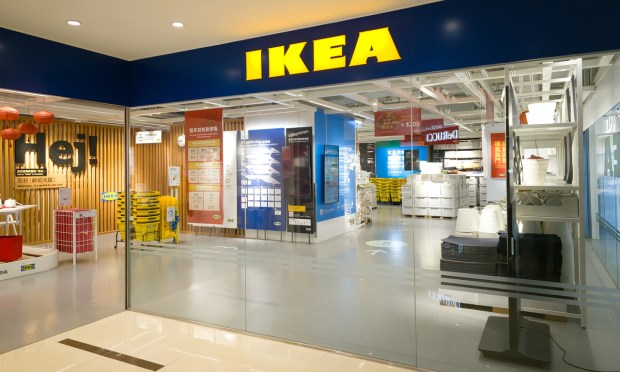IKEA US CEO Shares 2024 Strategy to Blend Retail, Payments and AI for Shopper Appeal

IKEA’s unique, maze-like retail format has consistently appealed to consumers worldwide.
At the core of IKEA’s success lies its self-service and exploration model, where the stores serve as expansive showrooms, encouraging customers to navigate through various room displays. This hands-on experience enables shoppers to visualize how furniture and accessories can enhance their living spaces.
Despite IKEA’s reputation for providing a stimulating retail experience, the retailer remains adaptable to change, especially in response to evolving consumer preferences. Recently, IKEA announced plans to introduce smaller format stores, making its offerings more accessible to consumers. However, there’s more behind the IKEA curtain.
In a recent interview with PYMNTS, Javier Quiñones, IKEA U.S. CEO and chief sustainability officer, sheds light on IKEA’s strategies for 2024, revealing how the retailer is staying at the top of consumers’ minds.
“Our expansion approach reflects the continued growth of city living and changing consumer lifestyles,” Quiñones said.
“We have identified geographic areas in the market that are beyond a 30-minute drive from existing stores and where affinity for IKEA is extremely high.”
Through the new format stores, Quiñones said consumers expect new touch points such as Plan & Order Point locations, which have been specifically tailored for larger metropolitan areas. However, Quiñones also emphasized that IKEA’s big stores will remain a be a big part of the IKEA experience.
The reason for the newer, smaller stores is to be more accessible, convenient and affordable. This regional approach allows IKEA to boost its presence in various areas, catering to specific regional and local needs. The aim is to meet customers where they are.
However, its strategy to reach a broader audience and remain top-of-mind for consumers extends beyond making physical retail modifications.
“Our strategy to grow our business is investing heavily both in eCommerce and newer, more accessible store formats to meet customers where they are and how they like to shop.”
Supporting this, Quiñones cited a statistic indicating a growing embrace of digital platforms in the U.S. This is evidenced by 3.3% growth in eCommerce during FY23 and a 6.3% increase in online visits compared to FY22.
Quiñones noted that IKEA has implemented various changes to tap into the eCommerce potential and enhance its alignment with consumer needs. The company has introduced online appointment booking and digital quotation tools catering to both individual consumers and business-to-business customers.
Furthermore, enhancements to the IKEA shopping experience include improved services, such as automated buyback valuation and web-based inventory.
Convenient Payment
In September, PYMNTS reported IKEA had ventured into the buy now, pay later (BNPL) sector with the assistance of Afterpay.
The program, which allows customers to pay for products in four payments over a six-week period, was launched at a time when cost-conscious consumers were continuing to use deferred payment offerings like BNPL to fund their purchases.
“IKEA values our customers and strives to ensure accessibility and affordability” said Christine Briganti, financial services deployment project leader for IKEA U.S., in a statement provided to PYMNTS. “By partnering with Afterpay, we will lower the barriers for our customers to design their dream spaces.”
During the launch, PYMNTS indicated that deferred payment tools such as credit card installment plans and BNPL options had become popular among consumers. It’s a convenient means to manage spending and make larger purchases more affordable.
In a survey conducted by PYMNTS Intelligence and AWS, it was revealed that individuals opt for deferred payment plans for three reasons: convenience, financial support, and the ability to purchase more products. The study indicated that within the three months leading up to the report, 28% of consumers used deferred payment plans, encompassing options such as BNPL and credit card installments.
Read more: IKEA and Afterpay Bring BNPL to Furniture Buying
As reported by PYMNTS, more than 40% of BNPL users said the unavailability of this payment option would lead them to either delay their purchase or choose a less expensive product.
Read more: BNPL’s Surge in 2023: Impact, Adoption and Regulatory Crossroads
How AI Plays a Role at IKEA
“It’s impossible to ignore the growing role that AI is playing for retailers and consumers alike,” Quiñones said.
In 2022, IKEA launched a new experience app called Kreativ, using AI for consumers to conceptualize and design living spaces. According to Quiñones, Kreativ combines IKEA’s life-at-home expertise with advancements in spatial computing, machine learning, and 3D mixed reality technologies. The interface aims to assist customers in visualizing furnishings in their homes through interactive design experiences, inspiring creativity and providing functional insights.
What’s to Come in 2024
“FY24 is off to a strong start, and we are energized and excited for what’s next in the upcoming year,” Quiñones said.
In addition to opening four IKEA locations, FY24 will see the introduction of new format stores in various locations, including Annapolis and Gaithersburg in Maryland, and Katy, Texas, set to open in spring 2024. Southlake, Texas, and Fairfax and Arlington, Virginia, are already open for business.
In 2024, Quiñones says IKEA is anticipating hosting the second biannual One Home One Planet conference in Washington, D.C., in March, gathering stakeholders and organizers to discuss topics such as circularity, affordable housing and clean construction.
